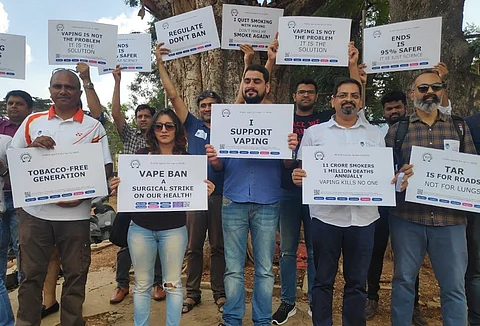

"Have you seen smokers having steady hands like us?" quips a protester holding up a placard that reads, "I quit smoking with vaping. Don't make me smoke again."
Inside Bengaluru's Freedom Park, a huddle of around 30 people are holding up placards while a group of journalists click photographs and videos of them. A placard reads,"The government is denying science, Vaping is safer.”
This is the first protest organised in Bengaluru by the Association of Vapers India (AVI), an organisation that represents e-cigarette users, against the ban on electronic cigarettes introduced by the union government earlier this month.
Here’s how it works – e-cigarettes heat up a liquid into vapour which is inhaled. It could taste anything from bubblegum to chocolate or just tobacco, and contains nicotine. These are called electronic nicotine delivery systems (ENDS) and are known by many names – vapes, e-hookahs, e-pipes, etc. They are now banned in India.
On Saturday, protests were held simultaneously in Indian cities including New Delhi and Hyderabad. In Bengaluru, this was the first time vape users came together to organise a protest.
'I quit smoking through vaping'
Among the protesters was Gautham Hanumanthappa, a 38-year-old marketing professional from Bengaluru. "I started smoking at the age of 16 and all attempts to stop smoking, like using a nicotine patch or chewing gum, did not work for me. I began vaping and gradually reduced my nicotine intake. This helped me to eventually quit smoking," says Gautham.
Gautam's story is similar to several testimonials shared by e-cigarette users about how it helped them gradually reduce the addiction to nicotine and eventually stop smoking. However, the protesting e-cigarette users are quick to make the distinction that e-cigarettes are useful only for smokers and should not be used by non-smokers.
"E-cigarettes, unlike conventional cigarettes, do not burn tobacco or produce tar or carbon monoxide. This fact alone makes it less harmful than cigarettes. Moreover, there is no evidence of vaping causing harm to others unlike second-hand smoke,” says Pingal Khan, an e-cigarette user and lawyer based in Bengaluru.
'Regulate but do not prohibit'
On September 18, the Union Cabinet approved the Prohibition of Electronic Cigarettes (production, manufacture, import, export, transport, sale, distribution, storage and advertisement) Ordinance, 2019. The ordinance states that anyone violating this rule will be imprisoned for up to one year or fined up to ₹1,00,000 or both, for the first offence. The central government has cited health reasons and the influence of e-cigarettes on the youth in the country for introducing the ban. It was deemed necessary to prevent the initiation of smoking for non-smokers and the youth after several consultations conducted by the Union Health Ministry going back to 2014.
However, protesters claimed that this can be resolved by introducing regulations for the sale and manufacture of e-cigarettes instead of prohibiting it.
"Regulate the sale of nicotine and impose taxes on it. This way, the government can earn more money and also ensure that e-cigarette vendors are not forced to shut down or worse, go underground and operate an unregulated market,” says Rukam Verma, a 32-year-old software engineer from Bengaluru. E-cigarettes are also expensive and for someone starting the use of e-cigarettes, it may cost upto Rs 3,000.
The protesting e-cigarette users also noted that the shares of cigarette makers, including ITC Ltd rose, Godfrey Phillips India Ltd, VST Industries Ltd and Golden Tobacco Ltd, rose after the government's decision to ban e-cigarettes was announced.
'Do it yourself' mentality
Ever since the ban was introduced, e-cigarette users complain that there is a lack of availability of e-juice or e-liquid, the flavoured nicotine mixture used in e-cigarettes, and some say, it has pushed them to smoke again. Others inside the vaping community say that it has prompted them to adopt a do-it-yourself mentality and create their own flavoured nicotine mixture.
"You need Vegetable Glycerine (VG), propylene glycol (PG), diluted nicotine, flavour and distilled water to create your own vape juice. It could take anywhere between two weeks and months to brew this depending on the complexity of the flavour,” says an e-cigarette user, who did not wish to be named.
The ingredients used are commonly available since VG and PG are used in the cosmetic industry and the flavours used are edible flavours that are also used to make pastries and other food products. However, the e-cigarette users warn that these liquids are not tested to check whether they are safe for inhalation.
Protestors also claimed that the Indian government was denying evidence that e-cigarettes are less harmful than smoking tobacco. In May, the Union Health Ministry issued a circular cautioning government departments to hold off publishing research, reports or studies on e-cigarettes and other devices promoted as an alternative to tobacco addiction without the consultation of the ministry.
The protesters say that this does not allow researchers to prove or disprove the effects of the use of e-cigarettes in the future and categorically dismisses a potential option for smokers to switch to a less-harmful alternative.
Two court cases that could yet influence the status of the ban are currently being heard by the Kolkata High Court, including one by Plume Vapour, an e-cigarette importer.